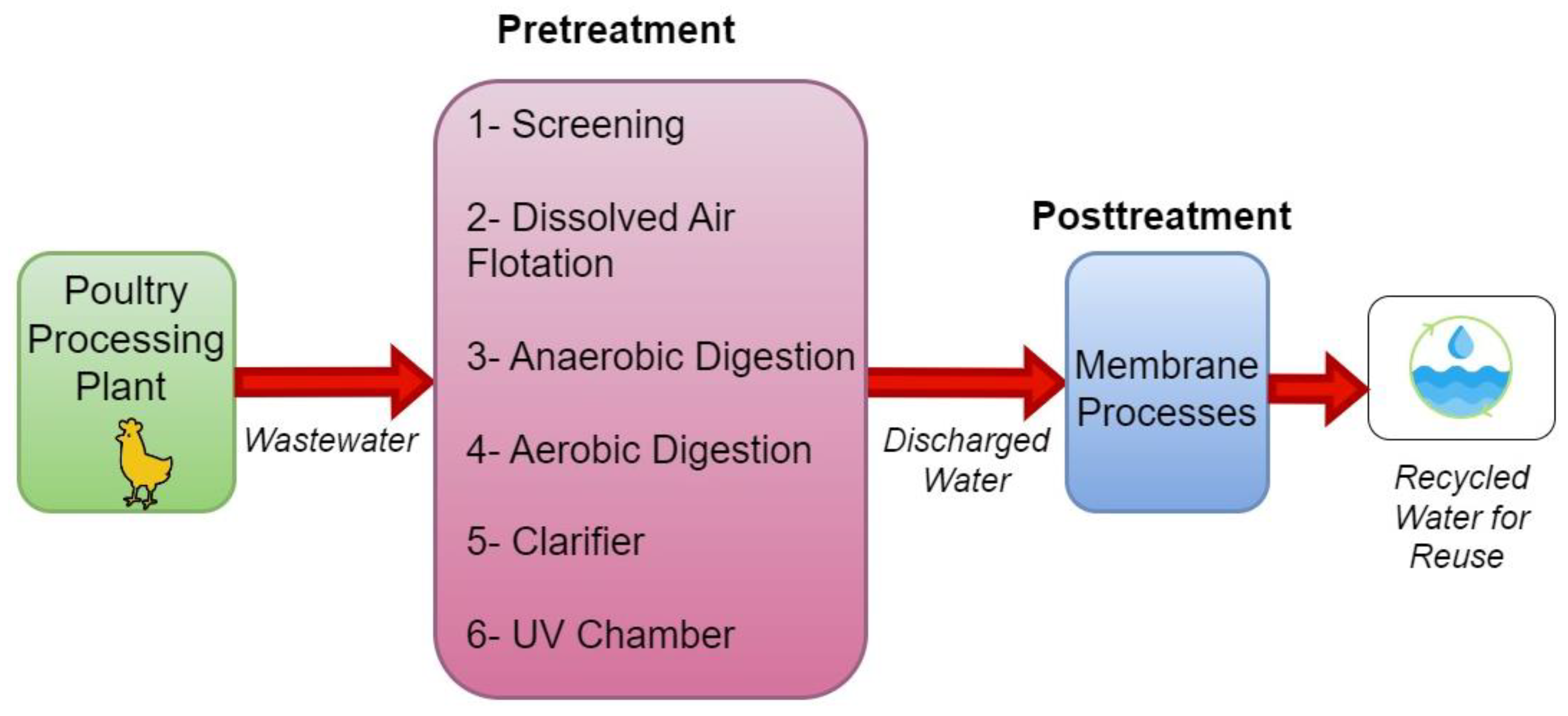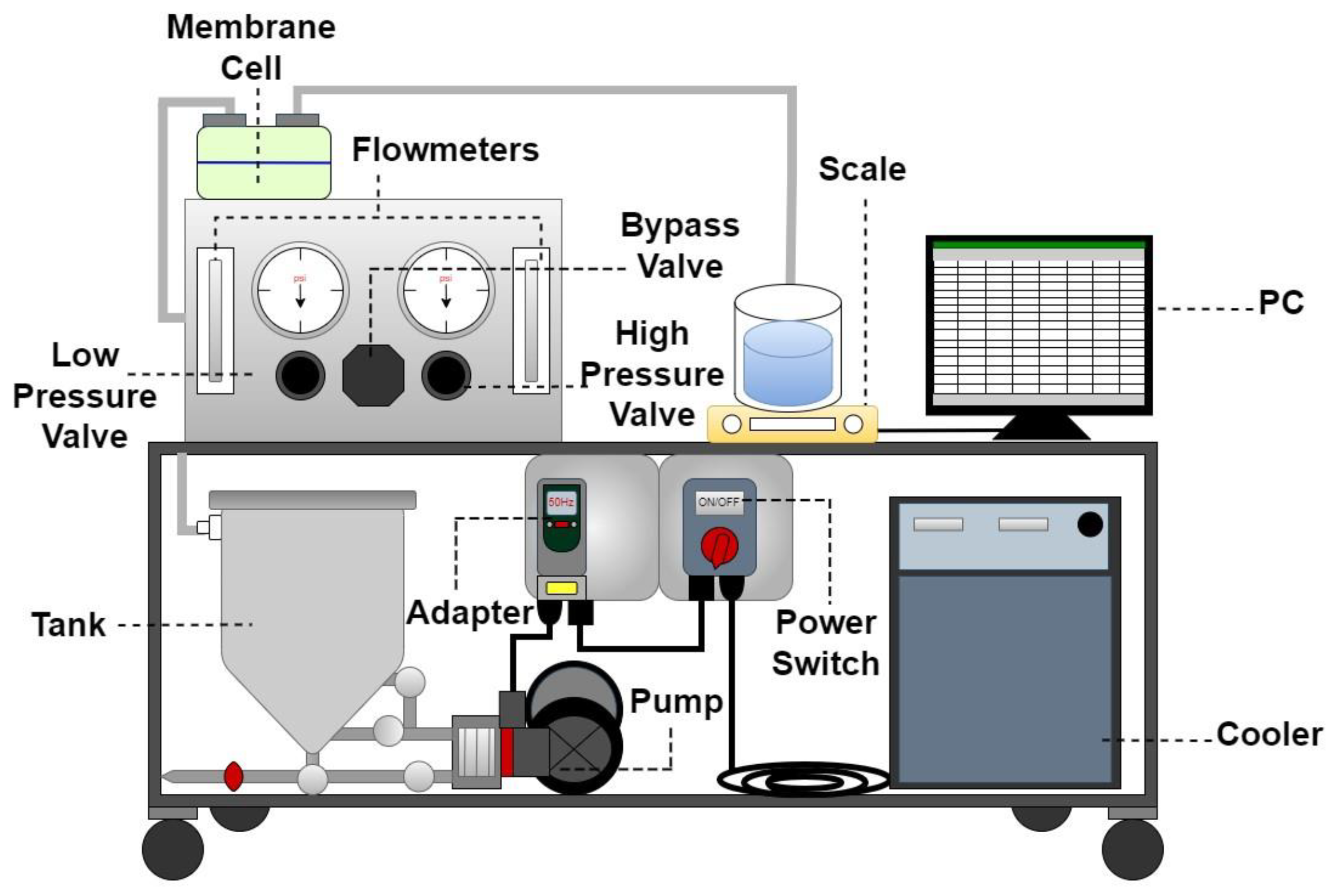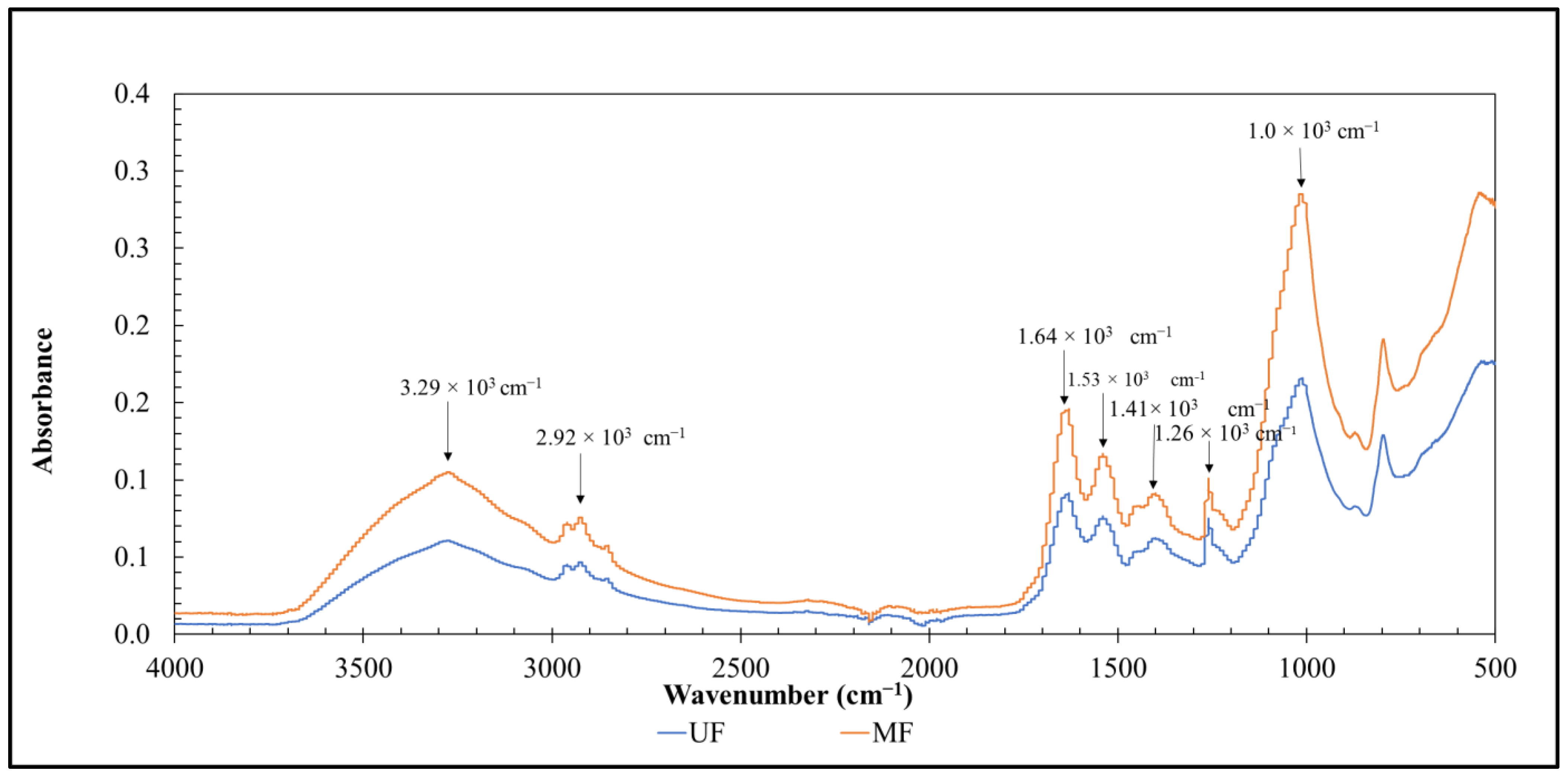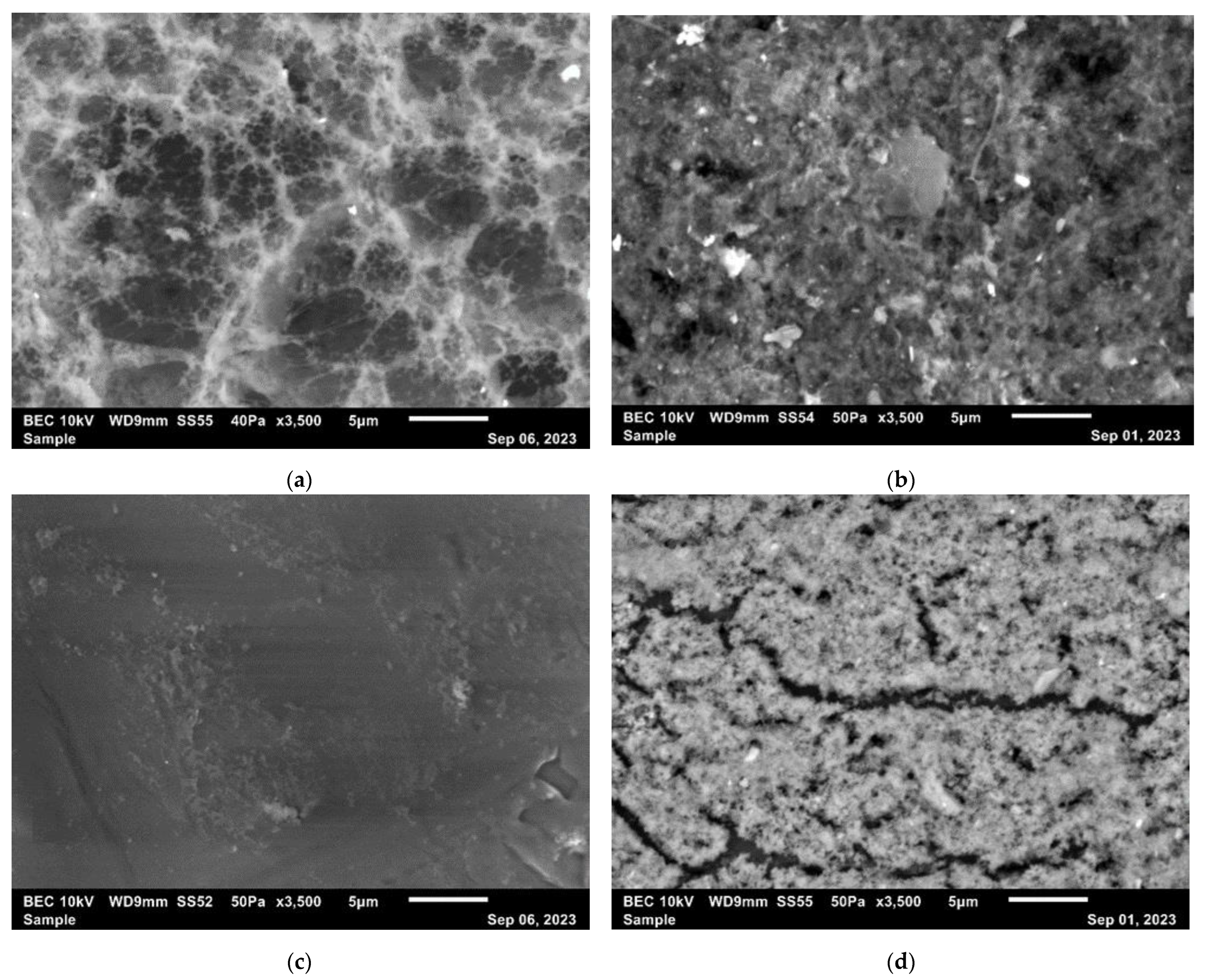An Evaluation of Microfiltration and Ultrafiltration Pretreatment on the Performance of Reverse Osmosis for Recycling Poultry Slaughterhouse Wastewater
Abstract
1. Introduction
2. Materials and Methods
2.1. Poultry Slaughterhouse Wastewater Characterization
2.2. Pretreatment of Poultry Slaughterhouse Wastewater with Ultrafiltration and Microfiltration
2.3. Characterization of Microfiltration and Ultrafiltration Foulants
2.4. Treatment of Poultry Slaughterhouse Wastewater with Reverse Osmosis
2.5. Economic Analysis
3. Results
3.1. Characterization of Poultry Slaughterhouse Wastewater
3.2. Pretreatment of Poultry Slaughterhouse Wastewater with Ultrafiltration and Microfiltration
3.2.1. Characterization of Microfiltration and Ultrafiltration Permeate
3.2.2. Average Flux and Rejection Coefficient of Microfiltration and Ultrafiltration
3.3. Foulants’ Characterization
3.3.1. Thermogravimetric Analyzer
3.3.2. Fourier Transform Infrared Spectroscopy
3.3.3. Scanning Electron Microscopy–Energy Dispersive X-ray Spectroscopy
3.4. Treatment of Poultry Slaughterhouse Wastewater with Microfiltration–Reverse Osmosis, Ultrafiltration–Reverse Osmosis, and Direct Reverse Osmosis
3.4.1. Characterization of Microfiltration–Reverse Osmosis, Ultrafiltration–Reverse Osmosis, and Reverse Osmosis Permeate
3.4.2. Real-Time Flux, Average Flux, and Rejection Coefficient of Microfiltration–Reverse Osmosis, Ultrafiltration–Reverse Osmosis, and Direct Reverse Osmosis
3.5. Economic Analysis
3.5.1. Wastewater Treatment Cost
3.5.2. Freshwater Consumption Cost
3.5.3. Total Cost
4. Conclusions
Author Contributions
Funding
Data Availability Statement
Conflicts of Interest
Abbreviation
| COD | Chemical oxygen demand |
| EDS | Energy dispersive X-ray spectroscopy |
| FTIR | Fourier-transform infrared spectroscopy |
| Jav | Average flux |
| Jw | Real-time flux |
| MF | Microfiltration |
| MWCO | Molecular weight cut-off |
| PES | Polyether sulfone |
| PVDF | Polyvinylidene fluoride |
| PSWW | Poultry slaughterhouse wastewater |
| R | Rejection coefficient |
| RO | Reverse osmosis |
| SEM | Scanning electron microscopy |
| TGA | Thermogravimetric analysis |
| TDSs | Total dissolved solids |
| TFSs | Total fixed solids |
| TN | Total nitrogen |
| TP | Total phosphorous |
| TSs | Total solids |
| TSSs | Total suspended solids |
| TVSs | Total volatile solids |
| UF | Ultrafiltration |
References
- Issaoui, M.; Jellali, S.; Zorpas, A.A.; Dutournie, P. Membrane Technology for Sustainable Water Resources Management: Challenges and Future Projections. Sustain. Chem. Pharm. 2022, 25, 100590. [Google Scholar] [CrossRef]
- Garnier, C.; Guiga, W.; Lameloise, M.L.; Degrand, L.; Fargues, C. Treatment of Cauliflower Processing Wastewater by Nanofiltration and Reverse Osmosis in View of Recycling. J. Food Eng. 2022, 317, 110863. [Google Scholar] [CrossRef]
- Baker, B.R.; Mohamed, R.; Al-Gheethi, A.; Aziz, H.A. Advanced Technologies for Poultry Slaughterhouse Wastewater Treatment: A Systematic Review. J. Dispers. Sci. Technol. 2020, 42, 880–899. [Google Scholar] [CrossRef]
- Optimizing Water Reuse in Meat and Poultry Processing. Available online: https://www.watertechonline.com/water-reuse/article/14223701/optimizing-water-reuse-in-meat-and-poultry-processing (accessed on 25 September 2023).
- Maggie, N.; Bingoa, M.B.; Ntwampea, S.K.O. Poultry Slaughterhouse Wastewater Treatment Plant Design Advancements. In Proceedings of the 16th SOUTH AFRICA Int’l Conference on Agricultural, Chemical, Biological & Environmental Sciences, Johannesburg, South Africa, 18–19 November 2019. [Google Scholar]
- Njoya, M.; Basitere, M.; Ntwampe, S.K.O. Analysis of the Characteristics of Poultry Slaughterhouse Wastewater (PSW) and Its Treatability. Water Pract. Technol. 2019, 14, 959–970. [Google Scholar] [CrossRef]
- Ng, M.; Dalhatou, S.; Wilson, J.; Kamdem, B.P.; Temitope, M.B.; Paumo, H.K.; Djelal, H.; Assadi, A.A.; Nguyen-tri, P.; Kane, A. Characterization of Slaughterhouse Wastewater and Development of Treatment Techniques: A Review. Processes 2022, 10, 1300. [Google Scholar] [CrossRef]
- Fatima, F.; Du, H.; Kommalapati, R.R. Treatment of Poultry Slaughterhouse Wastewater with Membrane Technologies: A Review. Water 2021, 13, 1905. [Google Scholar] [CrossRef]
- Matsumura, E.M.; Mierzwa, J.C. Water Conservation and Reuse in Poultry Processing Plant-A Case Study. Resour. Conserv. Recycl. 2008, 52, 835–842. [Google Scholar] [CrossRef]
- Shih, J.C.H.; Kozink, M.B. Ultrafiltration Treatment of Poultry Processing Wastewater and Recovery of a Nutritional By-Product. Poult. Sci. 1980, 59, 247–252. [Google Scholar] [CrossRef]
- Brião, V.B.; Vieira Salla, A.C.; Miorando, T.; Hemkemeier, M.; Cadore Favaretto, D.P. Water Recovery from Dairy Rinse Water by Reverse Osmosis: Giving Value to Water and Milk Solids. Resour. Conserv. Recycl. 2019, 140, 313–323. [Google Scholar] [CrossRef]
- Zheng, L.; Wang, X.; Wang, X. Reuse of Reverse Osmosis Concentrate in Textile and Dyeing Industry by Combined Process of Persulfate Oxidation and Lime-Soda Softening. J. Clean. Prod. 2015, 108, 525–533. [Google Scholar] [CrossRef]
- Egea-Corbacho Lopera, A.; Gutiérrez Ruiz, S.; Quiroga Alonso, J.M. Removal of Emerging Contaminants from Wastewater Using Reverse Osmosis for Its Subsequent Reuse: Pilot Plant. J. Water Process Eng. 2019, 29, 100800. [Google Scholar] [CrossRef]
- Yildirim, O.; Tunay, D.; Ozkaya, B. Reuse of Sea Water Reverse Osmosis Brine to Produce Dunaliella Salina Based β-Carotene as a Valuable Bioproduct: A Circular Bioeconomy Perspective. J. Environ. Manag. 2022, 302, 114024. [Google Scholar] [CrossRef]
- Hernández, K.; Muro, C.; Ortega, R.E.; Velazquez, S.; Riera, F. Water Recovery by Treatment of Food Industry Wastewater Using Membrane Processes. Environ. Technol. 2021, 42, 775–788. [Google Scholar] [CrossRef]
- Jafarinejad, S.; Jafarinejad, S. A Comprehensive Study on the Application of Reverse Osmosis (RO) Technology for the Petroleum Industry Wastewater Treatment. J. Water Environ. Nanotechnol. 2017, 2, 243–264. [Google Scholar] [CrossRef]
- Ezugbe, E.O.; Rathilal, S. Membrane Technologies in Wastewater Treatment: A Review. Membranes 2020, 10, 89. [Google Scholar] [CrossRef]
- Zubair, M.M.; Saleem, H.; Zaidi, S.J. Recent Progress in Reverse Osmosis Modeling: An Overview. Desalination 2023, 564, 116705. [Google Scholar] [CrossRef]
- Ahmed, M.A.; Amin, S.; Mohamed, A.A. Fouling in Reverse Osmosis Membranes: Monitoring, Characterization, Mitigation Strategies and Future Directions. Heliyon 2023, 9, e14908. [Google Scholar] [CrossRef]
- Malaeb, L.; Ayoub, G.M. Reverse Osmosis Technology for Water Treatment: State of the Art Review. Desalination 2011, 267, 1–8. [Google Scholar] [CrossRef]
- Jamaly, S.; Darwish, N.N.; Ahmed, I.; Hasan, S.W. A Short Review on Reverse Osmosis Pretreatment Technologies. Desalination 2014, 354, 30–38. [Google Scholar] [CrossRef]
- Coskun, T.; Debik, E.; Kabuk, H.A.; Manav Demir, N.; Basturk, I.; Yildirim, B.; Temizel, D.; Kucuk, S. Treatment of Poultry Slaughterhouse Wastewater Using a Membrane Process, Water Reuse, and Economic Analysis. Desalin. Water Treat. 2016, 57, 4944–4951. [Google Scholar] [CrossRef]
- Meiramkulova, K.; Zorpas, A.A.; Orynbekov, D.; Zhumagulov, M.; Saspugayeva, G.; Kydyrbekova, A.; Mkilima, T.; Inglezakis, V.J. The Effect of Scale on the Performance of an Integrated Poultry Slaughterhouse Wastewater Treatment Process. Sustainability 2020, 12, 4679. [Google Scholar] [CrossRef]
- Abboah-afari, E.; Kiepper, B.H. Membrane Filtration of Poultry Processing Wastewater: I. Pre-DAF (Dissolved Air Flotation). Appl. Eng. Agric. 2012, 28, 231–236. [Google Scholar] [CrossRef]
- Abboah-afari, E.; Kiepper, B.H. The Use of Membrane Filtration as an Alternative Pretreatment Method For Poultry Processing Wastewater. In Proceedings of the 2011 Georgia Water Resources Conference, Athens, GA, USA, 11–13 April 2011. [Google Scholar]
- Yordanov, D. Preliminary Study of the Efficiency of Ultrafiltration Treatment of Poultry Slaughterhouse Wastewater. Bulg. J. Agric. Sci. 2010, 16, 700–704. [Google Scholar]
- Marchesi, C.M.; Paliga, M.; Oro, C.E.D.; Dallago, R.M.; Zin, G.; Di Luccio, M.; Oliveira, J.V.; Tres, M.V. Use of Membranes for the Treatment and Reuse of Water from the Pre-Cooling System of Chicken Carcasses. Environ. Technol. 2019, 42, 126–133. [Google Scholar] [CrossRef]
- Mannapperuma, J.D.; Santos, M.R. Reconditioning of Poultry Chiller Overflow by Ultrafiltration. J. Food Process Eng. 2004, 27, 497–516. [Google Scholar] [CrossRef]
- Basitere, M.; Rinquest, Z.; Njoya, M.; Sheldon, M.S.; Ntwampe, S.K.O. Treatment of Poultry Slaughterhouse Wastewater Using a Static Granular Bed Reactor (SGBR) Coupled with Ultrafiltration (UF) Membrane System. Water Sci. Technol. 2017, 76, 106–114. [Google Scholar] [CrossRef]
- Meiramkulova, K.; Devrishov, D.; Zhumagulov, M.; Arystanova, S.; Karagoishin, Z.; Marzanova, S.; Kydyrbekova, A.; Mkilima, T.; Li, J. Performance of an Integrated Membrane Process with Electrochemical Pre-Treatment on Poultry Slaughterhouse Wastewater Purification. Membranes 2020, 10, 256. [Google Scholar] [CrossRef]
- UF Flat-Sheet Performance Comparison by Manufacturer. Available online: https://www.sterlitech.com/sy-mk-ultrafiltration-uf-membrane-cf042-size.html (accessed on 25 September 2023).
- RO Flat-Sheet Performance Comparison by Manufacturer. Available online: https://www.sterlitech.com/dow-sw30xfr-reverse-osmosis-ro-membrane-305-x-305-mm-size.html (accessed on 25 September 2023).
- MF Flat-Sheet Performance Comparison by Manufacturer. Available online: https://www.sterlitech.com/synder-membrane-filters-v0-2-pvdf-mf-150mm-5-pk.html (accessed on 25 September 2023).
- Pérez, G.; Gómez, P.; Ortiz, I.; Urtiaga, A. Techno-Economic Assessment of a Membrane-Based Wastewater Reclamation Process. Desalination 2022, 522, 115409. [Google Scholar] [CrossRef]
- College Station Water Rates. Available online: https://opendoc.cstx.gov/DocArc/Browse.aspx?id=1444875&dbid=0&repo=DOCUMENT-SERVER&cr=1 (accessed on 7 February 2024).
- Arizona Water Rates. Available online: https://www.goodyearaz.gov/government/departments/finance/utilities-customer-service/service-rates (accessed on 7 February 2024).
- Virginia Water Rates. Available online: https://www.arlingtonva.us/Government/Programs/Water-Utilities/Customer-Service/Rates (accessed on 7 February 2024).
- Goswami, K.P.; Pugazhenthi, G. Treatment of Poultry Slaughterhouse Wastewater Using Tubular Microfiltration Membrane with Fly Ash as Key Precursor. J. Water Process Eng. 2020, 37, 101361. [Google Scholar] [CrossRef]
- Amir, R.M.; Anjum, F.M.; Khan, M.I.; Khan, M.R.; Pasha, I.; Nadeem, M. Application of Fourier Transform Infrared (FTIR) Spectroscopy for the Identification of Wheat Varieties. J. Food Sci. Technol. 2013, 50, 1018–1023. [Google Scholar] [CrossRef]
- Phukan, R.; Guttierez, L.; De Schepper, W.; Vanoppen, M.; Verbeken, K.; Raes, K.; Verliefde, A.; Cornelissen, E. Short Term Fouling Tests on Homogeneous and Heterogeneous Anion-Exchange Membranes from Food and Bio-Based Industrial Streams: Foulant Identification and Characterization. Sep. Purif. Technol. 2023, 322, 124247. [Google Scholar] [CrossRef]
- Total Nitrogen. Available online: https://nepis.epa.gov/Exe/ZyPURL.cgi?Dockey=P10070OQ.TXT (accessed on 7 February 2024).
- Drinking Water Regulations and Contaminants. Available online: https://www.epa.gov/sdwa/drinking-water-regulations-and-contaminants (accessed on 7 February 2024).
- Summary Table for Evaluation of Drinking Water Quality Goals. Available online: https://www.waterboards.ca.gov/rwqcb5/water_issues/drinking_water_policy/summary_table.pdf (accessed on 7 February 2024).
- Fatima, F.; Du, H.; Kommalapati, R.R. A Sequential Membrane Process of Ultrafiltration Forward Osmosis and Reverse Osmosis for Poultry Slaughterhouse Wastewater Treatment and Reuse. Membranes 2023, 13, 296. [Google Scholar] [CrossRef] [PubMed]
- Perceptions of Water Scarcity in Charlottesville, Virginia. Available online: https://libraetd.lib.virginia.edu/public_view/v118rg170 (accessed on 7 February 2024).
- Drought. Available online: https://www.azwater.gov/drought/drought-status (accessed on 7 February 2024).
- Chen, J.; Dai, R.; Wang, Z. Closing the Loop of Membranes by Recycling End-of-Life Membranes: Comparative Life Cycle Assessment and Economic Analysis. Resour. Conserv. Recycl. 2023, 198, 107153. [Google Scholar] [CrossRef]
- Seibel, F.I.; Brião, V.B.; Maxime, P.; Seibel, F.I.; Otávio, G.; Giubel, M.; Barbosa Brião, V.; Shabani, M.; Pontié, M. End-of-Life Reverse Osmosis Membranes: Recycle Procedure and Its Applications for the Treatment of Brackish. J. Appl. Res. Water Wastewater 2021, 8, 77–87. [Google Scholar]







| Standard Method | Hach Method | |
|---|---|---|
| TSs | 2540 B | Hach 8271 |
| TSSs | 2540 D | Hach 8158 |
| TDSs | 2540 C | Hach 8163 |
| TFSs | 2540 E | Hach 8276 |
| TVSs | 2540 E | Hach 8276 |
| COD | 5220 D | Hach 8000 |
| TN | 4500 N—E | Hach 10072 |
| TP | 4500 B—C | Hach 10127 |
| Parameters | MF | UF | RO |
|---|---|---|---|
| Feed type | Industrial wastewater | Industrial wastewater | Industrial wastewater |
| pH | 1–11 | 1–11 | 1–13 |
| Pore size/MWCO | 0.2 µm | 30,000 Da | - |
| Polymer | PVDF | PES | PA-TFC |
| Membrane module | Flat sheet | Flat sheet | Flat sheet |
| Wastewater Treatment Unit Cost USD/m3 | |
|---|---|
| Conventional | 0.36 |
| Conventional + MF-RO | 1.37 |
| Conventional + UF-RO | 1.38 |
| Conventional + RO | 3.8 |
| Freshwater Consumption Unit Cost USD/m3 | |
|---|---|
| College Station, TX, USA | 0.8 |
| Goodyear, AZ, USA | 1.36 |
| Arlington, VA, USA | 1.46 |
| Parameters | PSWW | MF Permeate (mg/L) | MF Removal Efficiency (%) | UF Permeate (mg/L) | UF Removal Efficiency (%) |
|---|---|---|---|---|---|
| TSs | 2016 ± 82.7 | 1706 ± 16.9 | 15.4 | 1643 ± 32.9 | 18.5 |
| TVSs | 403 ± 27.6 | 128 ± 16.5 | 68.2 | 121 ± 2.4 | 70.0 |
| TFSs | 1613 ± 55.1 | 1577 ± 0.4 | 2.2 | 1521 ± 0.4 | 5.7 |
| TSSs | 4 ± 0.4 | 0.0 | 100 | 0.0 | 100 |
| TDSs | 2012 ± 82.3 | 1706 ± 16.9 | 15.2 | 1643 ± 32.9 | 18.3 |
| COD | 34 ± 0.7 | 25 ± 2.8 | 26.5 | 31 ± 0.9 | 8.8 |
| TP | 54 ± 0.4 | 51 ± 0.2 | 5.6 | 45 ± 0.1 | 16.7 |
| TN | 252 ± 2.1 | 171 ± 2.1 | 32.1 | 158 ± 6.3 | 37.3 |
| Average Flux (L/m2-h) | Rejection Coefficient | |
|---|---|---|
| MF | 152.2 | 0.2 |
| UF | 55.1 | 0.4 |
| Parameters | PSWW (mg/L) | MF-RO Permeate (mg/L) | MF-RO Removal Efficiency (%) | UF-RO Permeate (mg/L) | UF-RO Removal Efficiency (%) | Direct RO Permeate (mg/L) | Direct RO Removal Efficiency (%) |
|---|---|---|---|---|---|---|---|
| TSs | 2016 ± 82.7 | 250 ± 0.0 | 87.5 | 166 ± 62.4 | 91.8 | 325 ± 20.41 | 83.9 |
| TVSs | 403 ± 27.6 | 100 ± 0.0 | 75.2 | 66.7 ± 23.6 | 83.4 | 216 ± 47.1 | 46 |
| TFSs | 1613 ± 55.1 | 150 ± 0.0 | 90.7 | 100 ± 38.8 | 93.8 | 75 ± 25 | 95.4 |
| TDSs | 2012 ± 82.3 | 250 ± 0.0 | 87.5 | 166 ± 62.4 | 91.7 | 325 ± 20.41 | 83.8 |
| COD | 34 ± 0.7 | <3 ± 0.0 * | >91.2 | <3 ± 0.0 * | >91.2 | <3 ± 0.0 * | >91.2 |
| TP | 54 ± 0.4 | 0 ± 0.0 | 100 | 0 ± 0.0 | 100 | 0 ± 0.0 | 100 |
| TN | 252 ± 2.1 | 5 ± 0.2 | 98.0 | 4 ± 0.1 | 98.4 | 9 ± 0.1 | 96.4 |
| Average Flux (L/m2-h) | Rejection Coefficient | |
|---|---|---|
| MF-RO | 54.5 | 0.94 |
| UF-RO | 54.1 | 0.96 |
| RO | 40.8 | 0.91 |
| College Station, Texas | Arlington, Virginia | Goodyear, Arizona | ||||||||
|---|---|---|---|---|---|---|---|---|---|---|
| Processes | Water Recovery Rate (%) | Water Recovery Rate (m3/day) | Freshwater Consumption (m3/day) | Wastewater Treatment Cost (USD/year) | Freshwater Consumption Cost (USD/year) | Total Cost (USD/year) | Freshwater Consumption Cost (USD/year) | Total Cost (USD/year) | Freshwater Consumption Cost (USD/year) | Total Cost (USD/year) |
| Conventional | - | - | 6098 | 823,535 | 1,780,616 | 2,604,151 | 3,027,047 | 3,850,582 | 3,249,624 | 4,073,159 |
| MF-RO | 73.5 | 4482 | 1616 | 3,049,305 | 471,872 | 3,521,177 | 802,182 | 3,851,487 | 861,166 | 3,910,471 |
| UF-RO | 67 | 4086 | 2012 | 3,071,563 | 587,504 | 3,659,067 | 998,757 | 4,070,320 | 1,072,195 | 4,143,758 |
| RO | 75 | 4574 | 1524 | 8,591,472 | 445,008 | 9,036,480 | 756,514 | 9,347,986 | 812,140 | 9,403,612 |
Disclaimer/Publisher’s Note: The statements, opinions and data contained in all publications are solely those of the individual author(s) and contributor(s) and not of MDPI and/or the editor(s). MDPI and/or the editor(s) disclaim responsibility for any injury to people or property resulting from any ideas, methods, instructions or products referred to in the content. |
© 2024 by the authors. Licensee MDPI, Basel, Switzerland. This article is an open access article distributed under the terms and conditions of the Creative Commons Attribution (CC BY) license (https://creativecommons.org/licenses/by/4.0/).
Share and Cite
Fatima, F.; Fatima, S.; Du, H.; Kommalapati, R.R. An Evaluation of Microfiltration and Ultrafiltration Pretreatment on the Performance of Reverse Osmosis for Recycling Poultry Slaughterhouse Wastewater. Separations 2024, 11, 115. https://doi.org/10.3390/separations11040115
Fatima F, Fatima S, Du H, Kommalapati RR. An Evaluation of Microfiltration and Ultrafiltration Pretreatment on the Performance of Reverse Osmosis for Recycling Poultry Slaughterhouse Wastewater. Separations. 2024; 11(4):115. https://doi.org/10.3390/separations11040115
Chicago/Turabian StyleFatima, Faryal, Sana Fatima, Hongbo Du, and Raghava Rao Kommalapati. 2024. "An Evaluation of Microfiltration and Ultrafiltration Pretreatment on the Performance of Reverse Osmosis for Recycling Poultry Slaughterhouse Wastewater" Separations 11, no. 4: 115. https://doi.org/10.3390/separations11040115
APA StyleFatima, F., Fatima, S., Du, H., & Kommalapati, R. R. (2024). An Evaluation of Microfiltration and Ultrafiltration Pretreatment on the Performance of Reverse Osmosis for Recycling Poultry Slaughterhouse Wastewater. Separations, 11(4), 115. https://doi.org/10.3390/separations11040115







